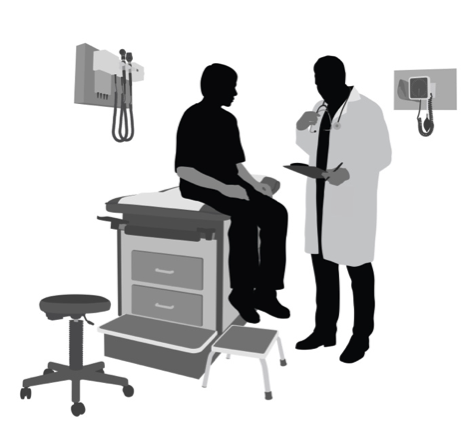
This year, the Team of Advisors has been thinking about partnerships in healthcare. They introduced the Partnership Principles, outlining ways to make the most of your relationships with the many people you encounter in your health journey — medical students, clinical trial coordinators, and “normals.” Now, they’re each sharing personal stories about these principles in action to kick off conversations about partnering. First up, during Parkinson’s Awareness Month, Jeff (Deak80) shares his experiences finding the right doctor and looking for “red flags,” communicating effectively, and sharing responsibility in his care.

As part of the Team of Advisors, we’ve been tasked to think about how we partner in our healthcare. Here are some examples of where, and more importantly how, I put the partnership principles to use. Remember that using the partnership principles is not a quick fix nor for one-time use. It’s important to establish a strong base through consistency of use and recognition that an effective partnership is based on a mutual respect and building a long-term relationship.
Know your needs in the partnership
Starting last December, I had the opportunity to put the partnership principles to use. Changes in my Medicare Part D prescription provider were driving me to change my Primary Care Provider (PCP). My previous year Part D insurer eliminated one of my Parkinson’s drugs from their formulary list. When I reviewed my options for prescription coverage (i.e., all my medications on an insurer’s formulary list), I had only 1 Part C HMO plan which met the requirements. (Those familiar with the basic construct of Medicare know that with a Part D plan you pair Medicare Supplemental Insurance to get complete coverage, or you use a Part C Advantage plan which covers both Health and Prescriptions).
Fortunately, my Parkinson’s specialist was covered under this HMO, but my PCP was not, so I began the search. I used the insurance company’s “Search for a Doctor” capability against a set of basic requirements:
- Within 10 miles of my house
- Has an internet healthcare rating of 3.5 or greater. (There are multiple rating services, I use this as a guide, not a rule.)
- If they are part of a doctors group that has provided care to me in the past, was it a good or negative experience?
Using this basic approach, I was able to identify two doctors at the same practice as a potential PCP. I called, and the one with the first available appointment became my PCP. Notice that the selection process of my PCP was short and not overly taxing. One reason for the expedited process is that during the first few appointments I am watching for “red flags” or areas of concern. If I encounter too many “red flags” I move on to another doctor. As indicated below, I did encounter too many “red flags,” and quickly selected another PCP. The only change I made to the new search is I expanded the range to 15 miles. I have met with my new PCP and I can tell that this PCP will be a much better match to the partnership principles than the first.
“As patients we may have to put more effort into the partnership to make it work…I am OK with this since I have the most to gain in the partnership.”
Establishing an effective patient-doctor partnership requires effective and efficient communications and recognition that a 50/50 partnership never exists. What this means is, as patients, we may have to put more effort into the partnership to make it work (>50%). Personally, I am OK with this since I have the most to gain in the partnership.
I look for effective and efficient communications within the doctor’s practice in two areas:
1. Does the office administration team communicate effectively with each other?
I have left more doctors due to poor office support and the office’s inability to manage a schedule than doctor/medical issues. The office administration is a key member of the doctor’s team. They are responsible for a lot of the information getting into your medical record as well as managing your access to the doctor. Some of the red flags to look for with the office administration are:
- Is some erroneous information sneaking into your medical file? A recent experience of mine in this area is that my birth date was entered incorrectly. Although I appreciated being 10 years younger, a lot of medical decisions, tests, etc., are driven by your age. I called three times over four weeks and they still had not corrected when I changed PCPs.
- Does the office run on time? I don’t mean necessarily to the minute, but are they even close? After relocating from Seattle to Boston, I selected my Parkinson’s specialist based on the recommendations of my doctors in Seattle. Although the doctor was medically very good, the office frequently ran over two hours late in the afternoon. These delays caused me significant stress. I was also working full-time at this point so the delays were also impacting work. Needless to say I changed specialists to one that was medically very good and the office runs almost always within 15 minutes of being on time.
2. Does the doctor’s office have the tools to communicate effectively with the patient?
You will hear phrases such as “patient portal” or “electronic medical record” (EMR) or “electronic health record” (EHR). In either case, these are referring to the system that a doctor typically uses to communicate with the patient. Usage varies between doctors. The PCP I now have is an active user of the EHR system. Even if your doctor is not an active EHR user, make sure you are. Access to this system provides you direct access to medical records (test results, surgeries performed, etc.).
Communicate effectively
Typically, I send an email about a week before my next visit to my Parkinson’s specialist. This approach provides me the opportunity to:
- Document how I have been doing since the last session
- Outline the objectives for this session
- List the questions I have for this session
- Allow the doctor to engage other resources if needed
More importantly it helps me organize, prioritize. Additionally, there is a much better chance of me remembering to cover everything in this email versus remembering onsite. Although my memory is still pretty good, relying only on your memory is setting yourself up for a disappointing meeting.
Share responsibility
Take personal ownership of my health. I am always trying to improve my situation. I attempt to eat right, get enough sleep and exercise regularly. I also put the effort into an effective patient/doctor partnership. As I mentioned above the patient/doctor partnership is not 50/50. I am not sure what the ratio is, but since the patient has the most to gain, logically they have to put the most into the partnership.
Finally, I found there’s a lack of real partnership in a lot of medical decisions. This lack of partnership is not just limited to the patient/doctor relationship. If you have multiple specialists involved, you may have to get them to meet together to discuss your case. Until you do, I have found that doctors follow a very linear process, and that joint decision making often does not occur.
You are your best patient advocate, so step up and take charge.
 Share this post on Twitter and help spread the word.
Share this post on Twitter and help spread the word.

This disease is a progressive disorder. Its symptoms stiffness and slowing movement can be worse with the time. Although Parkinson’s disease can’t be cured, medications, exercise, cardio, and boxing may markedly improve its symptoms.
CHECK WITH YOUR NEUROLOGIST BEFORE MAKING ANY CHANGES IN YOUR MEDICATION…LET THE DOCTOR READ THIS AND HELP YOU DECIDE IF THIS THEORY MAY HELP YOU…BY SLIGHTLY CHANGING THE WAY YOU DOSE YOUR SINAMET YOU MAY BE ABLE TO REDUCE SIDE EFFECTS AND TO EXTEND THE NUMBER OF YEARS IT WORKS….
STILL INTERESTED? READ ON!…(and no I am not selling anything!)
I am a secondary caregiver as my Father is going on his 12th year with Parkinsons.
The first 5 were bearable and my Mom managed ok. Dad got by without taking Sinamet, though he had a lot of side effects from Mirapex and Artane.
I was busy teaching Science and although I lived close, found it tough to find the time to help out….though I’d often come over on the weekends.
Years 5-10 became tougher as you know…Sinamet was introduced in year 7 and really helped for a while…but in year 11 Dad got Aspiration Pneumonia…spent a week in the hospital and was severly weakened. With slow rehab and excellent Physical Therapy, Dad improved to about 70%-80% of his pre-pneumonia condition. At 80 years old most Doctors wrote him off. He needed more care but did ok for 2 more years than the hospital doctors gave him. Here we are 2 years later though, and he has swallowing problems during his off periods. He has also developed dykinesias which no Neurolgist seemed able to help with. Then I came upon this theory in my countless internet searches:
The Pulsatile Theory of Levadopa Administration:
What does this mean? It means the Levadopa (L-Dopa or “Sinamet”) you take is in Big Chunks compared to the natural flow of a non Parkinsons person.
IT IS BELIEVED THAT IT IS THE TAKING OF SINAMET (L-Dopa)IN THIS FASHION THAT PRODUCES MANY OF THE WORST SIDE EFFECTS OF SINAMET…INCLUDING DYSKINESIAS, EXTENDED OFF PERIODS AND DRUG FAILURE.
I did this with my Dad and it really helped! Read on…
What does it mean? It means that when you take a tablet or 2 of Sinamet…the sudden rise of LDopa or falling off is stressful, and over time produces Dyskinesias…
So if for example you take a 2 tablet dose, ask your neurologist if you can take the two tablets 10-15 minutes apart. The first tablet you’d take just a a little BEFORE you normally would…and the second just a little AFTER you normally would…about 15 minutes apart may work (AGAIN…ASK YOUR NEUROLOGIST FIRST!)
WHY? By dividing up the dose you try to take the first tablet a little early JUST BEFORE your previous dose wears off. It keeps the L-Dopa level from falling too fast or too low….then the second tablet can later “Buoy” up the dose level, BUT avoiding a sharp spike.
My father takes a dose of 1 1/2 tablets 6 times a day. He had horrible peak dose dyskinesia, transitional (in between dose) dyskinesias and bad extended “off” periods and drug failure. I began dividing his doses in 3 half tablets, each 10 minutes apart…
HUGE DRAMATIC IMPROVEMENT….70%-80% BETTER IN ALL AREAS
I am just writing this because NO Neurolgist advised me about this. IN FACT, they looked at my Dad…and shrugged their shoulders and said , “Well, 12 years with Parkinsons….and….what can you do?”
I brought this idea to a great Neurolgist at the Veteran Administration in West Los Angeles and he helped me out line the dosing schedule.
Though my father’s has it tough, at least this has eased his discomfort some…
REMEMBER, THIS THEORY ADDS NO OTHER NEW DRUGS & SIMPLY FINE TUNES THE SINAMET YOU ARE ALREADY TAKING…IT MAY ALLOW YOU IN THE FUTURE TO TAKE LESS SINAMET…PERHAPS…
Again Ask your Neurolgist…BETTER YET, ASK 3 DIFFERENT ONES AND COMPARE THEIR ANSWERS..ASK QUESTIONS…BE RELENTLESS….OPTIMIZE YOU EXERCISE DIET AND SUPPLEMENTS (VITAMINS, ETC.)AND YOU’LL MAKE PROGRESS
Good luck…I hope this helps someone….in the name of my Dad…Ed
Love ya Dad…
Steve